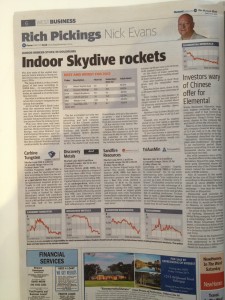Written by Christopher Golis and featured on www.evancarmichael.com.au
This was the title of a Executive Education seminar held last Tuesday night in Sydney hosted by UTS and sponsored by PriceWaterhouseCoopers. Based on the opening speech by the Chair, Dr David Band of UTS, the question posed was driven by the lack of venture capital and government support in Australia and the supposed solution requiring the entrepreneur going to Silicon Valley to raise VC.
There were two first-class entrepreneurs on the panel, Kathy Phelan and Richard White. Kathy is the Founder/CEO of Small World Social, a company which has developed an interactive online platform that puts the person back into the equation by explaining products, assisting people with the understanding of old and new technology and guiding them through complex systems. Richard is the Founder/CEO of WiseTech International, which is has developed several world class products including include CargoWise, a global leader in logistics technology solutions; and eHealthWise, a provider of electronic data services for the healthcare industry.
Both were spending a substantial part of the year overseas not however to raise capital but for reasons of marketing and management. Both used Australia to develop and beta test their products and then went overseas to scale their company.
Interestingly both had raised external capital not from VCs but from angels. The message they both gave was that you needed to be self-funding otherwise you would be screwed by either the VCs or angels no matter where they were located.
With regard to government support Richard is in the camp that believes best thing governments can do is get out of the way. Kathy was of a different opinion. First she described how she used the new Innovation Patents to protect her IP. She said that this had become particularly important when dealing with bankers and investors. She then described herself as first class ferret for obtaining government grants and benefits ranging from Comet Commercialisation grants to 457 visas. She had estimated that for the two businesses she had launched she had collected over $6 million in benefits.
While the question posed was never answered I would make the following observations.
The venture capital industry in Australia is effectively moribund. If the Australian Superfunds invest in venture capital they invest in USA venture capital funds. Interestingly USA VCs are now investing in Australian companies. This is a round-about way of getting there but it does seem to be occurring.
However there is has been major rise in angel funding in Australia. In addition the window for IPOs in Australia is beginning to open and this will probably be a major source of capital over the next five years. Indoor Sky Dive has just raised $12 million which 12 months ago would have been impossible.
If you do go to the US to try and raise capital remember it takes an entrepreneur something like 70 pitches to raise the ‘A’ round from Silicon Valley VCs. There are a lot more VCs there so you can make 70 pitches but it takes a considerable effort to do so.
Don’t underestimate the value of patents. Both Cochlear and Resmed had generated pretty hefty patent portfolio before they set out to raise funding. Finally a smart move, given the strength of the Australian dollar, would be to look to take over a US business in a similar industry rather than do a green-fields start-up.
Visit the original link here

